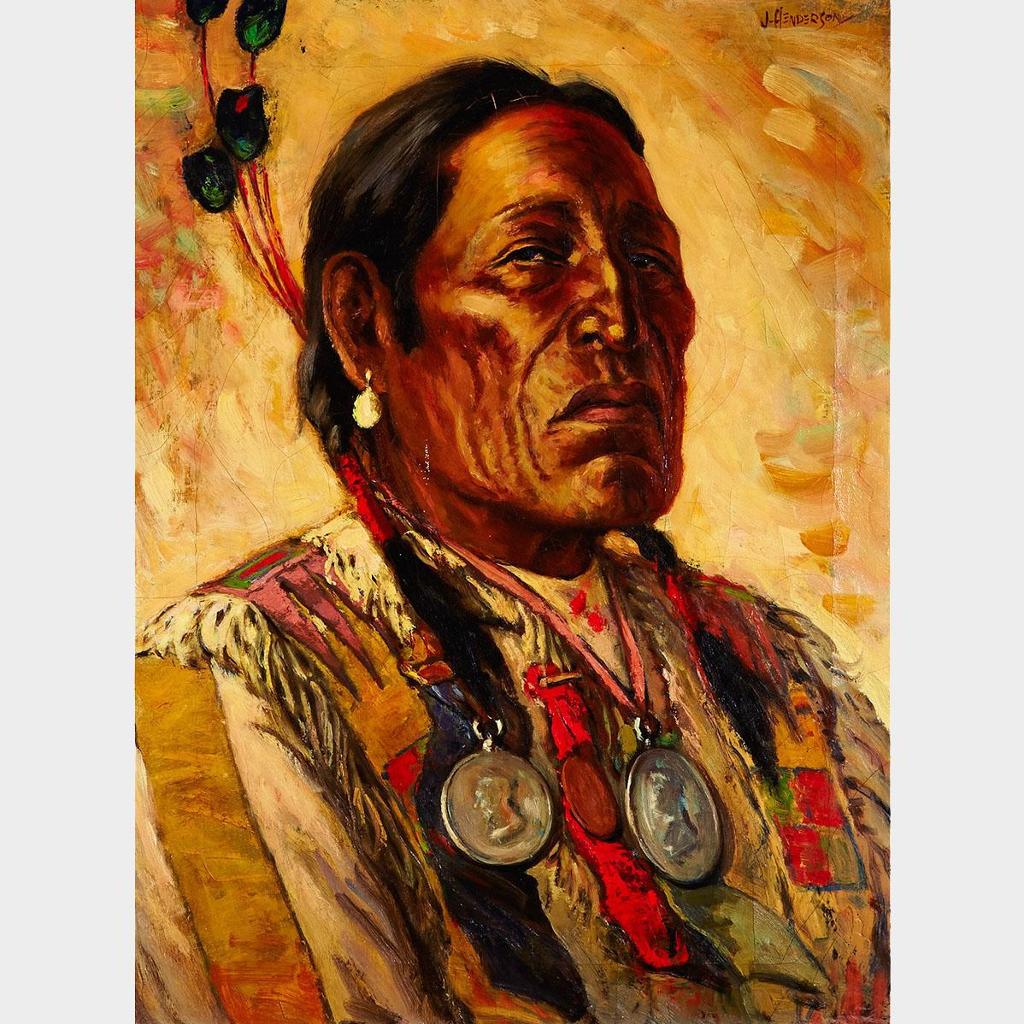
Portrait Of Chief-Shot-On- Both-Sides, Blood Indians (Cardston), Alta.
61 cms x 45.7 cms (24 ins x 18 ins)
Signed; Signed, Titled And Inscribed “Fort Qu’Appelle, Sask.” On The Reverse
Lot offered for sale by Waddington's, Toronto at the auction event "Canadian Fine Art Auction - Monday 26 May 2014" held on Mon, May 26, 2014.
Lot 87
Lot 87
Estimate: CAD $9,000 - $12,000
Realised: CAD $35,400
Realised: CAD $35,400
Lot description - from the online catalogue*
Provenance:
Private Collection, Ontario
Literature:
Dan Ring and Neal McLeod, James Henderson, Wicite Owapi Wicasa, the man who paints old men, Mendel Art Gallery, Sask., 2010, for the chapter entitled "Warriors of the High Plains" pages 68-77 and pages 68 & 150, cat. no. 87, for the closely related portrait of this sitter from 1927 in the collection of the National Gallery of Canada (purchased in 1928), reproduced in colour and page 160 for another closely related portrait of this sitter, c. 1927 in the collection of the Glenbow-Alberta Institute, Glenbow Museum, Calgary.
Notes:
The Blood Nation, to which Chief-Shot-on-Both-Sides belonged, is one of four tribes that form the Blackfoot Confederacy.
James Henderson painted Indian portraits from 1915-1951 and had a great number of clients eager to collect "Indian Heads" at a time when there was every reason to doubt the survival of the First Nations population in Canada. Colourful and sometimes nostalgic, the stories related to the sitters were as important to their popularity with collectors as the paintings themselves and Henderson chose his subjects carefully as a result. In her chapter entitled "Warriors of the High Plains", Linda Many Guns notes: "Shot on Both Sides was instrumental in maintaining the land mass that the Blood Nation can currently boast is the largest reserve in Canada... Often (the subjects of these paintings) were warriors first and foremost whose stories have become part of the public lexicon." Indeed, Shot-on-Both-Sides was a popular and proud man known for his strong convictions and, for those who knew him, this portrait is said to be a very close likeness that successfully captured the spirit of the man. The Treaty medals the sitter wears would have been handed down to him by a predecessor as they relate to treaties signed in 1877 when Chief Shot-on-Both-Sides would have been a mere child.
Henderson sometimes painted more than one version of his subjects and two paintings closely related to this one are known to have survived. One is in the collection of the Glenbow Museum in Calgary where it is currently on display. The second is in the collection of the National Gallery of Canada.
Private Collection, Ontario
Literature:
Dan Ring and Neal McLeod, James Henderson, Wicite Owapi Wicasa, the man who paints old men, Mendel Art Gallery, Sask., 2010, for the chapter entitled "Warriors of the High Plains" pages 68-77 and pages 68 & 150, cat. no. 87, for the closely related portrait of this sitter from 1927 in the collection of the National Gallery of Canada (purchased in 1928), reproduced in colour and page 160 for another closely related portrait of this sitter, c. 1927 in the collection of the Glenbow-Alberta Institute, Glenbow Museum, Calgary.
Notes:
The Blood Nation, to which Chief-Shot-on-Both-Sides belonged, is one of four tribes that form the Blackfoot Confederacy.
James Henderson painted Indian portraits from 1915-1951 and had a great number of clients eager to collect "Indian Heads" at a time when there was every reason to doubt the survival of the First Nations population in Canada. Colourful and sometimes nostalgic, the stories related to the sitters were as important to their popularity with collectors as the paintings themselves and Henderson chose his subjects carefully as a result. In her chapter entitled "Warriors of the High Plains", Linda Many Guns notes: "Shot on Both Sides was instrumental in maintaining the land mass that the Blood Nation can currently boast is the largest reserve in Canada... Often (the subjects of these paintings) were warriors first and foremost whose stories have become part of the public lexicon." Indeed, Shot-on-Both-Sides was a popular and proud man known for his strong convictions and, for those who knew him, this portrait is said to be a very close likeness that successfully captured the spirit of the man. The Treaty medals the sitter wears would have been handed down to him by a predecessor as they relate to treaties signed in 1877 when Chief Shot-on-Both-Sides would have been a mere child.
Henderson sometimes painted more than one version of his subjects and two paintings closely related to this one are known to have survived. One is in the collection of the Glenbow Museum in Calgary where it is currently on display. The second is in the collection of the National Gallery of Canada.
Most realised prices include the Buyer's Premium of 18-25%, but not the HST/GST Tax.
(*) Text and/or Image might be subject matter of Copyright. Check with Waddington's auction house for permission to use.
(*) Text and/or Image might be subject matter of Copyright. Check with Waddington's auction house for permission to use.